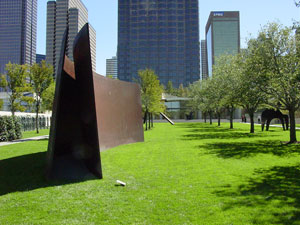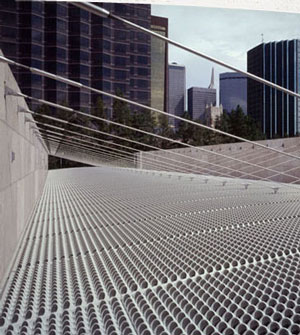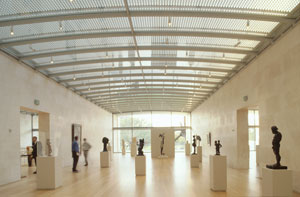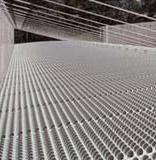It's been more than 150 years since Baudelaire wrote his essay Why Sculpture is Boring…
It's been more than 150 years since Baudelaire wrote his essay Why Sculpture is Boring. It has been almost 50 years since Ad Reinhardt, a painter, famously dissed sculpture, saying it's something you bump into when you back up to look at a painting.
And it has been a few weeks since the Nasher Sculpture Center opened in Dallas. Lodged between a highrise and a freeway, a concert hall and another art museum, it exudes quiet assurance. A museum devoted to sculpture? But, of course.
The Nasher wears its air of inevitability for several reasons. The first is that Reinhardt's snippy comment represented the last gasp of painting's primacy. During the past four or five decades sculpture has become the force for innovation in visual art — from primary objects to social sculpture, performance to earth works to more conventional, discrete objects. Painting has reasserted itself now and then, but anyone under 40 would be hard pressed to imagine a time when sculpture wasn't on top.
Another is that the Nasher collection is full of what an art historian friend of mine calls really, really, really good stuff. The drive to collect sculpture was initiated by Patsy Nasher: After she died in 1988, her husband, Raymond, continued to collect as a tribute to her. It's a generally conservative selection in the best sense of the word. And, in cases where a work originally raised more than a few eyebrows — for instance, Picasso's 1932 bronze head of a woman most certainly has a penis for a nose — canonization will leave most eyebrows serenely in place.
Incorporation into a canon takes place over time, as does the growth of familiarity. Both can be anathema to artists and others who live for ambiguity and transgression. But quality and consistently recognized importance have a place: they anchor the broader public awareness and bring up the general level of sophistication. Again, the possibility of ordinary people somehow obtaining a handle on art isn't a big concern for everyone involved in its making and dissemination, but it ensures art a place in modern culture.

View of the garden with the building at back. ...Pictured is Richard Serra's My Curves Are Not Mad, 1987
There are at least two more reasons why the Nasher feels like the right place at the right time. So many of the works from this collection have been in the public eye for years, at various museums around the country, as well as at North Park mall, that the sculpture center seems always to have been around in some form or another, just waiting to happen in this particular, very special, form.
And the architect for it, Renzo Piano, designed a building that almost anyone could slip into like a warm bath, without any awkward self-consciousness. It has huge windows on to the street so that people can see what they're getting in to before they enter. The garden end of the museum also is walled in glass, so that both street and garden immediately are visible from any point in the upstairs galleries, precluding claustrophobia. The surrounding skyline and glimpses of the street afforded through the garden's clear gates further a sense of connection to the world, even as the place offers a respite from the city's hustle.
Upstairs, the trajectory of the travertine block walls dividing the galleries is extended into the garden by alleys of oaks and other trees. The garden, itself, is simply laid out — a rectangle of tree- and sculpture-dotted lawn, gently sloping down from the galleries. And the relationship of small indoor works and larger outdoor works is as seamless as can be.
The building's roof is glass, protected from the elements by a lattice that also filters light. Natural light is an important element in museum architecture but, for sculpture, it's essential. Ironically, the magic that light works on sculpture, the way it animates sculpture and brings out accidental flashes of beauty, was one of Baudelaire's chief complaints. (Another was the viewers can walk around sculpture and choose however they wish to see it: This general unravelling of an artist's intent caused Baudelaire no end of consternation.) Anyway, concerns about hail damage and controlling light levels were the sorts of issues that discouraged Modern Art Museum of Fort Worth officials from pursuing original glass-ceilinged plans for that building — which makes the Nasher seem even more of a triumph.
Three of the upper level's five vaulted, parallel pavilions are devoted to exhibition, the other two house offices, a café and a shop. More offices, storage, an auditorium and one additional, artificially lighted, gallery are downstairs. The project's $70 million budget, paid for by the Nasher Foundation, includes land acquisition, construction and landscaping.
Understated and finely tuned as it is, the architecture and landscaping in no way exceed the importance of the art, in contrast with so many of the big museums built during the past 10 years. Instead it harks back to Houston's Menil Collection and Fort Worth's Kimbell Art Museum, as well as the newly rebuilt, but still wonderfully compact, Amon Carter Museum in Fort Worth.
Getting back to the collection itself, one of its prides is the depth of its holdings by David Smith (eight works), Alberto Giacometti (13 works), Matisse (11 works) and Picasso (seven sculptures, as well as some 2D works) among others. The opening installation's title is a bit misleading, though: From Rodin to Calder: Masterworks of Modern Sculpture from the Nasher Collection makes no reference to newer and important outdoor installations by Tony Cragg, Chris Burton, Magdelena Abakanowicz, Richard Serra and other late-20th-century artists.
But my own favorites, regardless of when they were made, are the five wax-coated plaster works by Medardo Rosso, along with the plaster models by Rodin and Raymond Duchamp-Villon. Looking at the pathetically creepy Rossos, including Sick Child (1889) and The Flesh of Others (1883-84), I wonder if Kiki Smith ever borrowed a page from his notebook. In a different vein, the Rodin plasters are warm and animated, as alluring as his bronzes are off-putting.

Naum GaboAmerican, born Russia, 1890-1977...Constructed Head No. 2, 1916 (enlargement 1975) ...Stainless steel, 70 x 54 1/4 x 48 in. ...Raymond and Patsy Nasher Collection, Dallas, Texas
And then there's Duchamp-Villon's 1911 portrait head of Baudelaire. Duchamp-Villon's more familiar bronze casts of Baudelaire's bare head are hard and gleaming, like a cyborg. But this powdery gray plaster original is a souvenir of death. It evidently was cast in two pieces — front and back — and joined after the plaster had begun to set up: The seam running up its neck and across the top of the skull doesn't really correspond to one for a cranial dissection, but it suggests it. And the numerous scratches and discolorations only add to the work's haunting presence.
What Baudelaire would have thought of this work, I don't know. But I doubt he'd have found it boring.
Images courtesy the Nasher Sculpture Center.
Janet Tyson is a writer and artist living in Fort Worth, TX.





